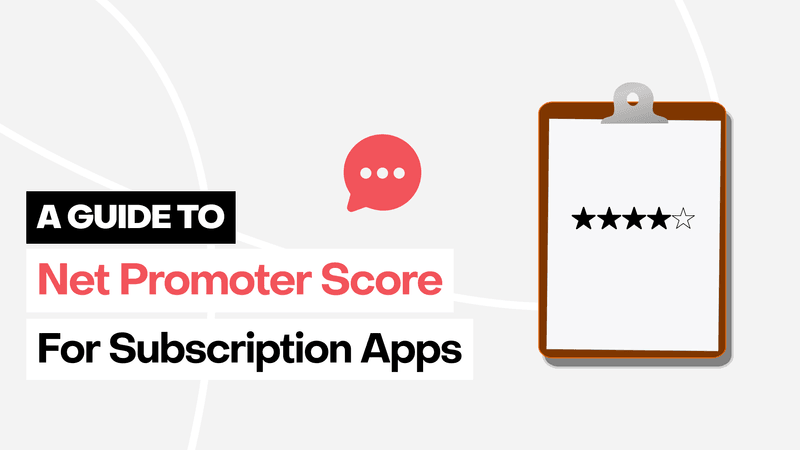Net Promoter Score (NPS) is a widely used metric for understanding customer loyalty. However, to use NPS effectively, it’s essential to be aware of its limitations and potential pitfalls. This guide explores how subscription app businesses can use NPS to boost user retention and growth, while avoiding common mistakes.
What is NPS and how is it calculated?
The Net Promoter Score (NPS) is a metric that gauges customer loyalty by asking users a simple question: “How likely are you to recommend our app to a friend or colleague?” Responses are rated on a scale from 0 to 10 and categorized as follows:
- Promoters (9-10): Loyal users who are likely to recommend your app.
- Passives (7-8): Satisfied users who aren’t enthusiastic enough to promote your app.
- Detractors (0-6): Unhappy users who may discourage others from using your app.
The NPS is calculated by subtracting the percentage of Detractors from the percentage of Promoters. Scores can range from -100 to +100, with higher scores indicating a stronger customer base.
How NPS can benefit subscription apps
In subscription models, understanding customer sentiment is important for maintaining and growing a user base. NPS is a useful tool for gauging overall satisfaction and identifying potential issues early.
NPS as an early warning system
One of the key advantages of NPS for subscription apps is its ability to act as an early warning system for churn. By monitoring NPS over time, you can spot trends that indicate declining user satisfaction, which might lead to cancellations. For example, a sudden drop in your NPS could signal a problem that needs immediate attention, such as a bug introduced in a recent update or a customer support issue.
Triggering CRM campaigns to detractors
NPS also allows you to segment your users based on their feedback, making it easier to take targeted action. Detractors — those who score your app between 0 and 6 — are at risk of churning, but with the right intervention, they can often be turned around. Using your CRM system, you can trigger automated campaigns that offer these users personalized help, special offers, or new features they haven’t explored yet. This proactive approach can help reduce churn and improve overall retention.
Using NPS as a safeguard for long-term product success
NPS can also be a safeguard when you’re making product changes. Leon Sasson, Co-Founder & CTO of Rise Science, shared on the Sub Club podcast how easy it is to A/B test your way into short-term wins — like boosting conversion rates or improving your funnel — but miss how these changes affect the bigger picture.
It’s tempting to focus on optimizing one metric, like conversion, and assume everything else will follow. But what happens if you streamline onboarding so much that users sign up quickly, but then have a poor experience later? Without a metric like NPS keeping track of overall user satisfaction, you could be improving one area while hurting another — like pushing conversion up, but engagement or retention down.
Countermeasures make sure that you didn’t move something in one direction but then you’re suffering later.
Leon Sasson, Co-Founder & CTO at Rise Science
To avoid this, use NPS as a countermetric. While you’re chasing quick wins, keep an eye on how users feel about the overall experience. If NPS drops, it’s a sign that you might need to adjust your approach to ensure the product stays valuable and enjoyable for the long term.
Best practices for implementing NPS in subscription apps
While NPS is a valuable metric, its effectiveness depends on how it’s implemented and used within your app. Here are some best practices for deploying NPS in a subscription context:
1. Designing your NPS survey
When deploying an NPS survey, especially within an app, it’s essential to ensure that the design is user-friendly and unbiased. Use individual buttons (0-10) rather than sliders or pre-selected options to prevent skewed results. To maximize engagement, consider triggering the survey in-app rather than through email, as in-app surveys tend to have higher response rates and capture users in a relevant context.
2. Segmenting your audience
To get the most out of your NPS data, segment your users. Separate free and paid users, as their experiences and satisfaction levels may differ significantly. For example, paid users often score higher, which could skew your overall results if not accounted for. Additionally, ensure you’re surveying active users who have had enough time to engage with your app’s core features.
3. Gathering qualitative feedback
Follow up the initial NPS question with an open-ended query to understand the “why” behind the score. This qualitative data is invaluable for uncovering specific pain points or opportunities for improvement that might not be evident from the score alone.
Common pitfalls and how to avoid them
While NPS is widely used, there are several common pitfalls that can diminish its effectiveness, particularly in subscription apps. Here’s how to avoid them:
1. Low response rates
NPS surveys, especially those sent via email, often suffer from low completion rates. To improve engagement, trigger NPS surveys in-app rather than relying solely on email. In-app surveys are less likely to be ignored and can be presented at a moment when users are already engaged with your product.
2. Avoiding confusing or double-barreled questions
NPS surveys should focus on one clear question: “How likely are you to recommend our app to a friend or colleague?” Avoid combining multiple questions into one (e.g. “How likely are you to recommend our app based on your experience with our features and customer service?”). Such “double-barreled” questions can confuse users and lead to unreliable data. Keep your survey question simple and straightforward to ensure clarity and accuracy.
3. Understanding NPS limitations
While NPS is a useful tool, it’s important to recognize its limitations. Studies show that NPS can be misunderstood by respondents due to its hypothetical nature, and it may not be the best predictor of future loyalty. To mitigate this, consider supplementing NPS with questions about recent behaviors or specific interactions with your app, which can provide more actionable insights.
4. Avoiding the NPS fallacy
NPS can be misused or gamed if it becomes the sole focus of customer feedback. As Goodhart’s Law suggests, when a measure becomes a target, it can lose its effectiveness. Ensure that your NPS surveys are used as part of a broader strategy that includes qualitative feedback and other metrics. This helps maintain the integrity of the data and prevents the score from becoming a vanity metric.
For more on pitfalls, check out this fun analysis: The Ugly Truth About Net Promoter Score Surveys
Using NPS data to drive subscription growth
Once you’ve collected NPS data, it’s time to put it to work. Here’s how you can leverage these insights to boost growth and retention in your subscription app:
1. Tracking NPS to predict and prevent churn
NPS is an essential tool in the broader context of churn detection. Monitoring NPS over time can reveal early warning signs of dissatisfaction that could lead to churn. For instance, a decline in NPS might indicate emerging issues that require immediate attention. Additionally, tracking app store reviews and customer support tickets can provide complementary insights into user sentiment.
2. Building a dashboard for continuous monitoring
Create a dashboard that tracks NPS over time, segmented by key user attributes like subscription status, country, or device type. By monitoring how scores fluctuate — especially after updates or feature launches — you can pinpoint what’s working and what needs adjustment.
3. Acting on feedback: Follow-up strategies
For Promoters: Engage promoters immediately by prompting them to leave a review on the app store or participate in referral programs. This not only helps with user acquisition but also reinforces their positive experience.
For Detractors: Address detractors by digging deeper into their feedback. Offer them incentives, like discounts or free trials, to give your app another shot. Use this opportunity to guide them toward new or underutilized features that might change their perception of the app.
4. Granular analysis for deeper insights
Don’t stop at the surface level—use your NPS data to conduct a granular analysis. Examine how scores vary by different segments, such as device type, geography, or session count. This can help you identify specific issues, like localization problems or platform-specific bugs, that are affecting user satisfaction.
In conclusion
While NPS is a valuable tool for measuring customer loyalty, it’s most effective when used in conjunction with other metrics and strategies tailored to the subscription model. By implementing NPS thoughtfully, segmenting your audience, and acting on the feedback, you can not only improve your product but also foster a loyal customer base that drives long-term growth.
Use this guide to refine your approach to NPS and make it an integral part of your subscription app’s growth strategy. Remember, the goal is not just to collect scores, but to turn insights into actions that enhance the user experience and fuel your app’s success.

